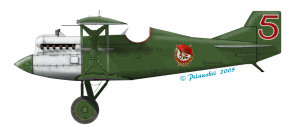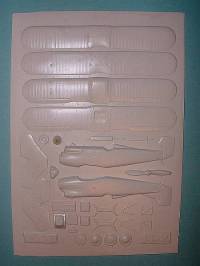Prop & Jet 1/72nd Grigorovich I-2bis
By Matt Bittner

Prop & Jet 1/72nd Grigorovich I-2bisBy Matt Bittner |
 |
(Note: You can find research on the I-2bis, done by Erik Pilawskii, in the Research section.)
 The
following is a translation of the history from the instructions:
The
following is a translation of the history from the instructions:
The first aircraft of indigenous construction to enter service with the VVS RKKA, and actually the first series-built Soviet fighter (the I-1 did not materialize). Altogether there were built 65 examples of the I-2, and 149 of the I-2bis. Although the aircraft did not have great performance, it was satisfactorily useful in reducing purchases of foreign technology. Continued military service until 1933. Later, it served well in the training role with defense organizations and instructional institutions.
Before Prop & Jet moved to resin (see my preview of their Nikitin NV-1) they made some of the best vacumforned models in the world. Not only were parts very crisp and nicely molded, most included extras, such as decals and metal parts (as is evident with this kit). There are 30 pieces on the vac sheet, some best used only as masters for scratchbuilt parts. Flying surfaces are not single-surface, necessary to capture the very distinct look found on these fighters. It shouldn't be that difficult to carefully separate all parts and join the halves together. "Hot" plastic cement (like liquid cement) is not recommended on the trailing surfaces, instead something like epoxy or CA should be used at least in this area.
As I mentioned above, the P&J I-2bis comes with metal parts, seven total. The prop, control column, rudder pedals, center struts and landing gear struts. Decals are for one scheme only, which is profiled in this article. Decals are spot on and in register.
 While
the instructions aren't laid out in steps, you'll want to tackle the interior
first. There is one small photo of some of the cockpit of a real I-2bis
in the CIS magazine Aviation Time, but that's the only reference I know
of for this aircraft. The vac sheet comes with a floor, instrument panel and
seat. Everything else will have to be added from the spare-parts bin
While
the instructions aren't laid out in steps, you'll want to tackle the interior
first. There is one small photo of some of the cockpit of a real I-2bis
in the CIS magazine Aviation Time, but that's the only reference I know
of for this aircraft. The vac sheet comes with a floor, instrument panel and
seat. Everything else will have to be added from the spare-parts bin
Once the cockpit is complete then the fuselage halves can be assembled. In addition all the flying surface halves can be brought together with eventual addition to the fuselage (except the upper wing, of course). One important item to be aware of. It appears the interplane struts had an "edge" to them. That is, there was what a modeler would consider "flash" running around the entire strut. It's thought these struts were pressed, thus giving that appearance.
 There
are a lot of smaller items that need to be fashioned from scratch - such as
the exhaust pipes - so place close attention to the instructions.
There
are a lot of smaller items that need to be fashioned from scratch - such as
the exhaust pipes - so place close attention to the instructions.
Once you're satisfied with all the items added prior to painting, painting can now commence, followed by the final assembly.
As I already mentioned, this is one of the best molded vacumformed kits around. Nice and crisp parts and the detail is just outstanding. While there is plenty of work you need to perform on this model yourself, currently it's the only kit available for the I-2bis. If it was only for that fact alone I would highly recommend this kit. However, with the level of detail and finess in this vac, I can also recommend it all 'round.
My thanks to Erik Pilawskii for performing the translations on the instruction sheet. Also thanks to him for creating an excellent research article on the type as well.
I'm trying to drum up interest in having Prop & Jet recast this model in resin. If you think you would want to see this aircraft as a resin model, then be sure to visit the Forum and partake in the Poll started in "Kit Reviews, New Kits, Rumours".
Aviation Time, 3/2000